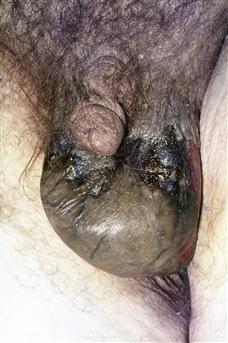Scrotal Pain
This may be due to lesions on the scrotal skin, within the scrotum, or may, rarely, be due to referred pain.
History
Skin
The patient may have noticed a skin lesion, which is itchy, sore or painful. In the elderly, confused and incontinent, pain and soreness may be due to the irritant effect of faeces and urine with superadded infection. Previous history of a superficial swelling may suggest an infected sebaceous cyst. There may be a history to suggest contact dermatitis. Painful vesicular lesions may suggest herpes. Behçet’s syndrome may cause painful ulcerative lesions of the scrotum and the patient may also have similar lesions on the penis. Fournier’s gangrene usually has acute onset in a young, healthy male with rapid progression to gangrene of the skin. There is often absence of a discernible cause.
Internal scrotal swellings
There may be a previous history of an inguinal hernia descending into the scrotum. Sudden onset of colicky abdominal pain and irreducibility may suggest the development of a strangulated inguinal hernia. Sudden onset of pain, redness and swelling in a teenager or young male suggests a diagnosis of testicular torsion. This may come on during vigorous exercise. This is a surgical emergency and needs urgent surgery. Gradual onset of pain, redness and tenderness will suggest epididymo-orchitis. Check for symptoms of urinary tract infection, e.g. dysuria or frequency, which may accompany epididymo-orchitis. Orchitis may be associated with mumps and this may be apparent, the patient complaining of bilateral painful parotid and submandibular glands, together with painful cervical lymphadenopathy and constitutional illness. A history of trauma will suggest haematocele. A dull ache, often poorly localised, may be associated with a varicocele.
Referred pain
Rarely, the patient may complain of pain in the scrotum, with no visible or palpable abnormality. Check for a history of previous inguinal hernia repair, which may have resulted in ilioinguinal nerve entrapment. Idiopathic cord neuralgia may occur but is rare. Occasionally ‘groin strain’ may cause scrotal pain. Referred pain from spinal lesions may rarely cause scrotal pain.
Examination
Skin
A red, scaly lesion will suggest dermatitis. There may be superadded infection. In the elderly and incontinent, the diagnosis of irritation from urine or faeces will usually be apparent. An infected sebaceous cyst will present as a localised, tender, red swelling on the scrotum. There may be purulent discharge. Herpes simplex will present with vesicular lesions. They may be present elsewhere, e.g. on the penis. Behçet’s disease will present with painful ulcerative lesions on the scrotum as well as on the penis. There may be other signs of Behçet’s disease, e.g. arthritis, keratitis, iritis, mouth ulcers. With Fournier’s gangrene, there is usually a tense, glossy oedema developing over the scrotum. Crepitations develop later before subcutaneous gangrene occurs. The gangrene may spread over the inguinal area and the lower abdominal wall. In the advanced case, the skin will have completely disappeared, leaving the testes hanging naked in the scrotum.
Internal scrotal swellings
There may be a tense, tender scrotal mass, which it is impossible to ‘get above’. This would suggest a strangulated hernia. The presence of an enlarged tender testicle drawn up towards the groin suggests testicular torsion. An enlarged tender testis with redness and scrotal oedema suggests epididymo-orchitis. The parotid and submandibular glands should be checked to exclude mumps. Occasionally, torsion of a testicular appendage may occur and cause pain and scrotal swelling out of all proportion to the size of the lesion, which may be less than a few millimetres in diameter. A tender swelling with scrotal bruising and oedema following trauma will suggest a haematocele (a collection of blood between the layers of the tunica vaginalis). A varicocele may not be obvious until the patient has been standing up for 10–15 seconds. Classically, it feels like a ‘bag of worms’ with the warm blood filling dilated veins, which are palpable through the scrotal skin. It is more common on the left-hand side. Rapid onset of a left-sided varicocele may be associated with carcinoma of the left kidney, the tumour growing down the left renal vein and obstructing the left testicular vein. Examine the abdomen for a left renal mass.
Referred pain
Check for the scar of an inguinal hernia repair. In ilioinguinal nerve entrapment, there will be anaesthesia/paraesthesia below the scar and on the anterior aspect of the scrotal skin. In the rare case where scrotal pain may be referred from a spinal lesion, a full neurological examination should be carried out. Examine the lumbosacral spine for localised tenderness.
General Investigations
Specific Investigations
■ Lumbosacral spine X-ray
Referred pain due to degenerative disease or metastases.
■ Laser Doppler
Check for testicular blood flow. Absent in testicular torsion.
■ Technetium scan
Testicular torsion (no outline of testis) versus epididymo-orchitis (good testicular blood flow).
■ US abdomen
Left renal carcinoma (varicocele).
■ Surgery
Diagnostic between torsion and infection. There is rarely the time or equipment to carry out laser Doppler or a technetium scan. If a testicular torsion is not dealt with within six hours of onset, there is likely to be permanent damage to the testis. If there is any doubt in the diagnosis, assume that it is torsion and explore the scrotum surgically.





